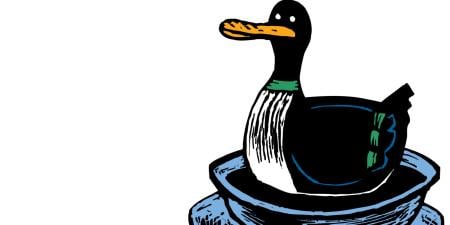Case
Jim, a retired attorney, is 70 and, for the last 15 years since receiving a pacemaker, has led a reasonably active life that includes some golf and occasionally throwing the football or baseball with his grandsons. He has always watched his diet and maintained a health-conscious lifestyle. He takes pride in his appearance and in looking younger than he is.
Both Jim and Dr. Austin, his internist, were shocked when an endoscopic biopsy confirmed that Jim had pancreatic cancer. Dr. Austin had been seeing Jim only every 18 or 20 months since his pacemaker surgery; he saw his cardiologist more frequently. He came to her to check out stomach pain that gradually had become constant and severe and a low-grade but persistent fever. Blood tests suggested that he had pancreatitis and a CT scan showed a mass obstructing the pancreatic duct. "Probably an impacted gall stone," Dr. Austin had said, hopefully. Then she ordered the endoscopy.
Dr. Austin was as honest as her knowledge and experience permitted in giving Jim a prognosis and explaining what he could anticipate. In her 20 years of practice, she said, she had followed about 7 patients with pancreatic cancer. The longest survival after diagnosis was over a year; the shortest was 3 weeks; the average was 3 to 6 months. But, she said, she hadn't treated such a patient in several years and didn't know how treatments and life expectancy had changed in that time. The best medical oncologist in the area, Dr. Austin said, was Dr. Maggio, and she would be happy to put a call into him right then while Jim was in her office.
Jim, appearing more calm than when the discussion began 20 minutes earlier, declined the referral, saying he didn't wish to spend his last 3 weeks to a year in doctors' offices and hospitals, undergoing and recovering from experimental treatments. "I watched my grandfather die from pancreatic cancer, and it was hell for him and everyone else. No," Jim said, "I'm going, as we say in both our professions, to put my affairs in order. Then, when things begin to go downhill, I'll come back and ask you to disconnect or turn off or however you do it, stop this ticker monitor in my chest," Jim patted his heart.
Another long discussion ensued, during which Dr. Austin cautioned that the disconnecting of Jim's pacemaker could very well not result in his immediate death. He would go along until some arrhythmia or other event occurred. If such an event left him temporarily unconscious or disabled, she cautioned, someone would probably call 911, and Jim would end up in an ICU, connected to this and that monitor—just what he wanted to avoid.
Jim countered that he would spread the word to his wife, son, daughter, and friends that he was not to be resuscitated or sent to the hospital—"and I won't go to the mall by myself," he joked. He did not intend to tell anyone about his plan to "discontinue the pacemaker treatment" as he insisted on putting it.
Back and forth the discussion went. Dr. Austin assured Jim that she could control his pain from the cancer, even at the last. Jim said he didn't want to be in la-la-land. After the long and exhausting conversation, Jim left, asking, with the uncompromising frankness of a dying man, that she help him die in the least objectionable and "obscene" way. "We both know I'm gonna die," Jim said, "Help me not die by degrees, suffer, and drag everybody through hell. Will you, Dr. Austin?"
It occurred to Dr. Austin that she might tell Jim to ask his cardiologist for help, but she rejected that approach. If helping Jim was the right thing to do, she should have the guts to do it. If it wasn't, she shouldn't suggest that someone else do it.
Commentary 1
Dr. Austin finds herself in the unenviable position of counseling a long-time patient and friend, Jim, who has pancreatic cancer. As difficult as end-of-life issues are, her dilemma is further compounded by Jim's insistence that his pacemaker be turned off when his condition deteriorates, allowing him potentially to die via cardiac causes, instead of lingering in the painful death throes of pancreatic cancer.
Dr. Austin has her reservations, and she reasons that terminating pacemaker therapy may not be effective in preventing an "objectionable and obscene" death, since misguided resuscitative measures by bystanders may place Jim in the ICU anyway. Jim counters that he will avoid the situation by staying close to family and friends who will know he doesn't want CPR, but he states he won't tell them about his decision to turn off the pacer.
Framing this case in terms of a conflict between a patient's right to make decisions about treatment limitations and medical recommendations about what is the most beneficial course of therapy provides a helpful starting point, but there are other issues that arise.
Cardiovascular Treatments: It's Not All about Mortality
Advances in medicine have dramatically improved survival for patients with a host of cardiovascular disorders. From open-heart surgery to PTCA with stenting to cocktails of medications, doctors have arsenals loaded with weapons against infirmities of the heart and blood vessels. Understandably, cardiovascular medicine has focused attention on patient longevity, often excluding other patient outcomes.
Successful prolongation of cardiovascular life allows patients to live long enough to die from other causes. The added years represent tremendous blessings to many patients. But for others, the added years are full of suffering. Although some cardiac conditions cause slow and uncomfortable deaths, dying from ventricular arrhythmia is relatively quick and painless. The heart stops contracting effectively, brain perfusion ceases, unconsciousness ensues, and the patient dies—quickly and painlessly.
It is easy to view a "code blue" as an invasive, degrading, and, often, futile medical treatment. But what about Automated Implantable Cardioverter/Defibrillators (AICD's), which detect lethal arrhythmias and shock the heart from the inside? Vice President Dick Cheney became a poster-child for these devices in 2001. They are routinely implanted in patients who survive cardiac arrests. A recent New England Journal article suggests that AICD's should be implanted in many more patients.1 There is no question that these devices prolong life. However, patients may suffer from multiple shocks, which, even though appropriate, are extremely uncomfortable and often necessitate hospitalization.2 In addition, devices sometimes malfunction and shock patients inappropriately. Some patients choose to have their devices turned off because they would rather die than undergo more shocks. Doctors often turn off the AICD's of patients suffering from terminal diseases. Although timing of death becomes less predictable, patients with terminal conditions may prefer a quick death.
So far, there has been little question about the ethical appropriateness of patients with terminal conditions deciding to turn the devices off or declining them in the first place. Since AICD may be considered analogous to CPR, the ethical resolution seems relatively straightforward: a patient with decision-making capacity may refuse both the initiation and continuation of AICD therapy.
What about Pacemakers?
In the case presented, Jim is asking to have his pacemaker turned off "when things begin to go downhill." Certainly, by accepted standards in medical ethics, Jim, as a competent adult, can refuse any treatment. But the question here turns on whether Jim is making an informed decision. In evaluating this case, Dr. Austin needs to probe further into 2 important areas.
The Clinical Scenario
Why was the pacer put in? There are many indications for pacemaker insertion.3 If Jim has third degree heart block with an escape rhythm incompatible with effective cerebral perfusion, he may die relatively painlessly once the pacemaker is discontinued. If, however, Jim is like most patients and had his pacemaker inserted for symptomatic bradycardia, he may be quite uncomfortable if his pacemaker is turned off. He may end up feeling extremely fatigued and possibly experience air hunger from congestive heart failure. Furthermore, disabling his pacemaker is unlikely to hasten his death.4 Discontinuation of pacemaker therapy may very well contribute to an "obscene" death "by degrees."
Thus, I suggest that Dr. Austin and Jim consult with Jim's cardiologist who can provide the reasons for pacemaker therapy and the consequences if it is discontinued. Although Dr. Austin's display of moral courage in not relying on others to make tough choices is admirable, ethical decisions often turn on the medical facts, and the expertise of other physicians often illuminates the facts. As in the rest of medicine, multidisciplinarity in approaching ethical dilemmas can prove useful.
Jim's Reasoning
Clinicians construct a differential diagnosis while patients recount their symptoms, then ask specific questions to narrow the list. Likewise, clinicians should develop a differential diagnosis for patient rejection of proposed treatments, then ask clarifying questions. In this case, Jim's desire to discontinue his pacemaker raises the need to dialogue about larger issues. Why does Jim not want to involve his family in the decision to turn off the pacer? (Does he fear that his family will oppose his decision or does he want to avoid disturbing family members with difficult choices?)
What does he mean by his stated wish to avoid putting "everyone through hell?" (Might his family and friends "rise to the occasion" and provide comfort and support that is essential as Jim goes through the dying process? In trying to protect them, might Jim prevent their involvement in a significant process?)
Has Jim witnessed family members or friends die in "obscene" ways that he is not necessarily destined to repeat? What are the symptoms Jim most wants to avoid?
Does Jim or any of his family or friends hold religious and cultural beliefs that may inform their values?
My Recommendation
Dr. Austin should explore the issues in subsequent visits and should advise Jim to involve his cardiologist. Addressing these questions may shed further light on Jim's approach to his illness and help Dr. Austin craft a treatment plan compatible with clinical realities and Jim's values. A decision to discontinue pacemaker use is reasonable within standards of medical ethics as long as Jim understands his condition, and Jim's physicians have made an attempt to understand Jim's values.
References
-
Moss AJ, Zareba W, Hall WJ, et al. The Multicenter Automatic Defibrillator Implantation Trial II Investigators. Prophylactic implantation of a defibrillator in patients with myocardial infarction and reduced ejection fraction. N Engl J Med. 2002;346(12):877-883.
- Korte T, Jung W, Ostermann G, et al. Hospital readmission after transvenous cardioverter/defibrillator implantation; a single centre study. Eur Heart J. 2000;21(14):1186-1191.
- Gregoratos G, Cheitlin MD, Conill A, et al. ACC/AHA guidelines for implantation of cardiac pacemakers and antiarrhythmia devices: a report of the American College of Cardiology/American Heart Association Task Force on Practice Guidelines. J Am Coll Cardiol. 1998;31(5):1175-1206.
- Braun TC, Hagen NA, Hatfield RE, Wyse DG. Cardiac pacemakers and implantable defibrillators in terminal care. J Pain Symptom Manag. 1999;18(2):126-131.



